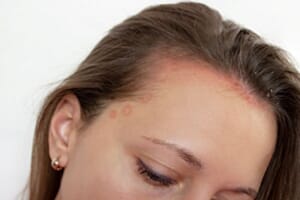What your skin can tell you about your circulation Although bad circulation affects a huge percentage of people in the UK – it’s extremely hard to spot. Many of the most obvious symptoms of bad circulation (dizziness, DVT, heart problems etc) tend to occur only when the problem has reached a very serious level. However a good way of detecting poor circulation before it poses a serious health risk is via your skin. Surprisingly your skin can tell you a great deal about the state of your cir
8 December, 2009 – 17:12
Here are 10 warning signs about your circulation that you see through your skin.
1. Skin sign – Ankle Eczema
Eczema that occurs just around the ankles could be a sign of poor circulation known as varicose eczema. This type of eczema affects the ankles and lower legs and is caused by poor circulation. Commonly the skin around the ankles is affected, becoming speckled, itchy and inflamed.
Treatment – Varicose eczema is usually not a very severe form of eczema so many sufferers might prefer to avoid using steroid creams if possible. A new natural treatment from Switzerland called Defensil, which has been clinically proven to help reduce symptoms associated with very dry skin and eczema better than hydrocortisone creams, could be a suitable option to steroids.
2. Skin sign – Chilblains
Chilblains are painful inflammations, usually on the toes, and are caused by poor circulation. Chilblains are red blotchy patches, which may become itchy, hot and painful. They may be swollen and the skin surface may crack. Women seem to be more prone than men to chilblains.
Treatment – Maintain an even temperature to your feet – avoid overheating with hot baths and showers, and the direct heat of electric blankets and hot water bottles. Keep the pressure off and if the skin is broken use a topical antibiotic cream from your GP. Many dermatologists suggest using a menthol or eucalyptus based product such as Vicks Vapour Rub to increase circulation.
3. Skin sign – White or Red Hands & Feet
Red hands and feet can be a sign of Raynaud's disease. The disease can be caused by underlying poor circulation and causes an interruption of blood flow to the fingers, toes, nose, and/or ears when a spasm occurs in the blood vessels of these areas. Typically, the affected area turns white then bright red over the course of the attack. There may be associated tingling, swelling, or painful throbbing. The attacks may last from minutes to hours.
Treatment – Most treatments for Reynaud’s disease to date have centre around minimizing or preventing exposure to cold and vasodilating medications. However, although it's been over 100 years since Raynaud's was recognized, little is still known about the condition or its cure.
4. Skin sign – Varicose Veins
Varicose veins are a sure sign of poor circulation. The veins most commonly affected by this problem are the ones just under the skin. Besides the obvious swelling of the veins, symptoms are aching legs, muscle cramps and a feeling of heaviness in the legs. Because of bruises, blood may leave the veins and ulcers on the leg may appear.
Treatment – Exercise and dietary changes to lose weight will be very beneficial to relieving varicose veins as well as improving overall circulation.
In addition Horse Chestnut (Aesculus hippocastanum) can help to increase blood flow up and out of the legs, strengthen connective tissue, tighten up veins, decrease redness and swelling. One of its compounds, Aescin, has been found to close the small pores in the walls of the veins, making them less permeable.
5. Skin sign – Slow healing wounds
Poor circulation plays a part in most wounds that do not heal readily. Diabetes provides an example of this, where there can be impaired circulation and altered carbohydrate metabolism. Not only are slow healing wounds a typical sign of poor circulation, they are also more prone to infection, which can lead to more serious consequences.
Treatment – Any wound that does not heal within a few weeks should be examined by a healthcare professional because it might be infected, might reflect an underlying circulatory problem such as diabetes.
6. Skin sign – Cellulite
If you have always had cellulite then it’s unlikely to be linked to poor circulation but a sudden cellulite development, with no dietary changes or general weight gain, may be a sign of an underlying circulatory problem.
The reasoning is that poor circulation causes a higher fluid density in the surface layer of fat. This prevents the fat from being properly absorbed into the blood and causes it to swell with excess fluids, thus stretching the connective tissue and leaving a lumpy, irregular and sometimes reddish appearance on the skin.
Treatment – A cheap and helpful way to improve the look of cellulite is to body brush the effected area with a bristle body brush once a day for 5-10 minutes to increase circulation in the localised area. In addition eating healthily and keeping your weight under control (although being slim doesn’t necessarily guard you against cellulite) and practicing exercises that focus on toning the bottoms and thigh area will also help.
7. Skin sign – Puffy skin around the calves, ankles and eyes
Poor circulation can lead to fluid retention, particularly in the lower legs, ankles and feet but also sometimes in the sensitive skin below and around the eyes.
Swollen feet and legs, referred to medically as leg oedema, occur when fluid is retained in the spaces between body cells. Swelling, heat and itchiness in the calf and ankle can also be a sign of DVT (Deep Vein Thrombosis). Both problems indicate poor circulation.
Treatment – Most DVT’s are not serious, but if you suspect you might have a DVT, you should seek medical advice immediately.
8. Skin sign – Chronic Athletes foot
Normal athlete’s foot is unlikely to be associated with poor circulation as it is caused by a fungal infection that is not related to blood flow. However, chronic and prolonged athlete’s foot that does not respond to treatment could be a sign of poor circulation and/or diabetes.
Treatment – You should follow the same treatment as for varicose veins.
9. Skin sign – Foot ulcers
A foot ulcer is an open sore on the foot that often appears to begin with as a shallow red crater that involves only the surface skin. A foot ulcer also can be very deep in which case there may be a crater that extends through the full thickness of the skin, which may involve tendons, bones and other deep structures. People with poor circulation are more likely to develop foot ulcers.
Treatment – If you do develop a foot ulcer you should see your GP immediately.
10. Skin sign – Skin darkening
Areas of darkened or orange coloured skin around the calves and ankles can be a sign of a skin condition called stasis dermatitis, which is a type of skin disorder than is caused by poor blood circulation in the lower legs. This type of dermatitis is usually accompanied by leg swelling and itching as well as darkening of patches of skin.
Treatment – Stasis is typicallycontrolled by compression dressings or stockings and sometimes topical steroids are prescribed. However due to the open and weeping wounds that are typical of this skin condition, topical steroids are usuallynot a solution as complete absorbtoin of steroids via an open wound can lead to skin ulceration and further complications. Therefore non-steroid alternatives can be benefical for managing this condition. Skin Shop's cooling Cardiospermum Gel is a non-steroid anti-inflammatory and anti-itching cooling gel that can be applied over large areas to help calm down skin and reduce itching. Visit www.sinshop.co.uk.







